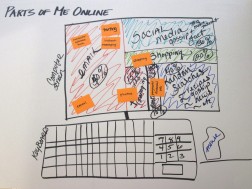As Lindsay mentioned earlier , we met with 14 people this summer to learn how they experience and manage their lives both in the real world and online. We visited people with different backgrounds, ages, and life situations in their homes, and asked them to tell us about their lives, and how online and offline intersect. We even asked them to draw their online lives for us:
What did we find? We learned that online identity is a complex topic, one not easily articulated by our participants. While everyone shopped and wrote email, other online activities varied from participant to participant. In order to get a handle on online identity, we looked at such factors as how participants use the Web, how aware they are of their online identity, and how they communicate.
We placed our participants into 5 groups:
- The Visitors, who are not social online and not aware of their online identity in day-to-day actions. They do not use social media– no Facebook, no LinkedIn, no Twitter.
- The Wallflowers, who have little awareness of online identity in day-to-day actions. Their representation of themselves online is neutral and their steps to manage online identity are very tactical. They use little social media. When publishing, they tend to be private (Shutterfly, etc).
- The Waders, who have some awareness of online identity in day-to-day actions. The representation of themselves online is personal, and the steps to manage online identity are mainly tactical. They do use social media, but always as themselves. They may comment online, for example, but always as “me.”
- The Curators, who are aware of online identity in many day-to-day actions. They represent themselves online publicly and continuously. Their steps to manage online identity are strategic. They are very social online, and for example, may use social media for business purposes. The Web supports their offline selves.
- The Tailors, who are aware of their online identity in most day-to-day actions and for whom a major part of their social lives are online. The Tailors are different because they see the Web as a rich ecosystem to play in and may not be afraid to be anonymous or pseudonymous online.
In an upcoming post, we’ll talk about how we might better serve these five groups. What can Mozilla do to support them?



Ping from Ideating without Borders at the Firefox UX Concept Week | Mozilla UX on